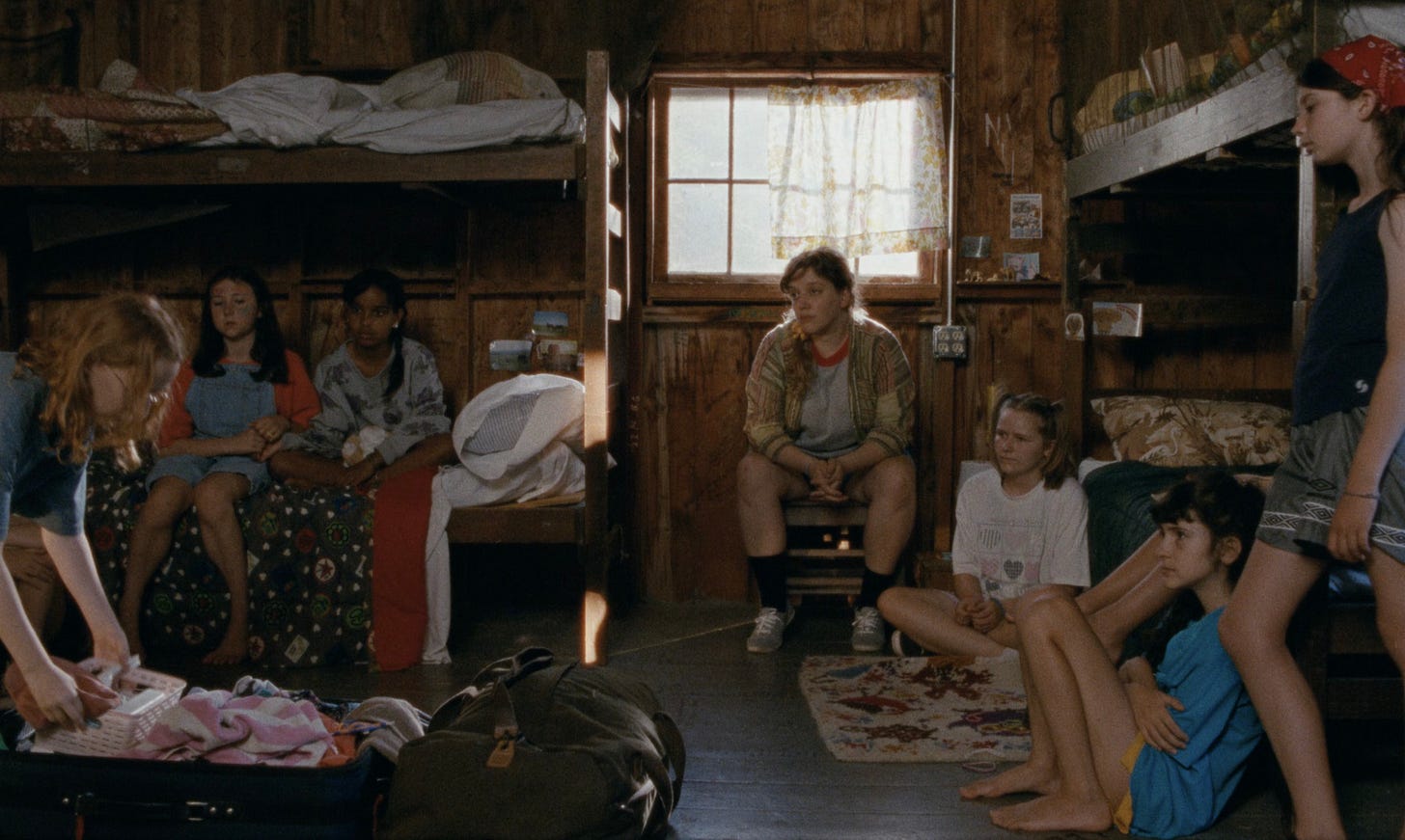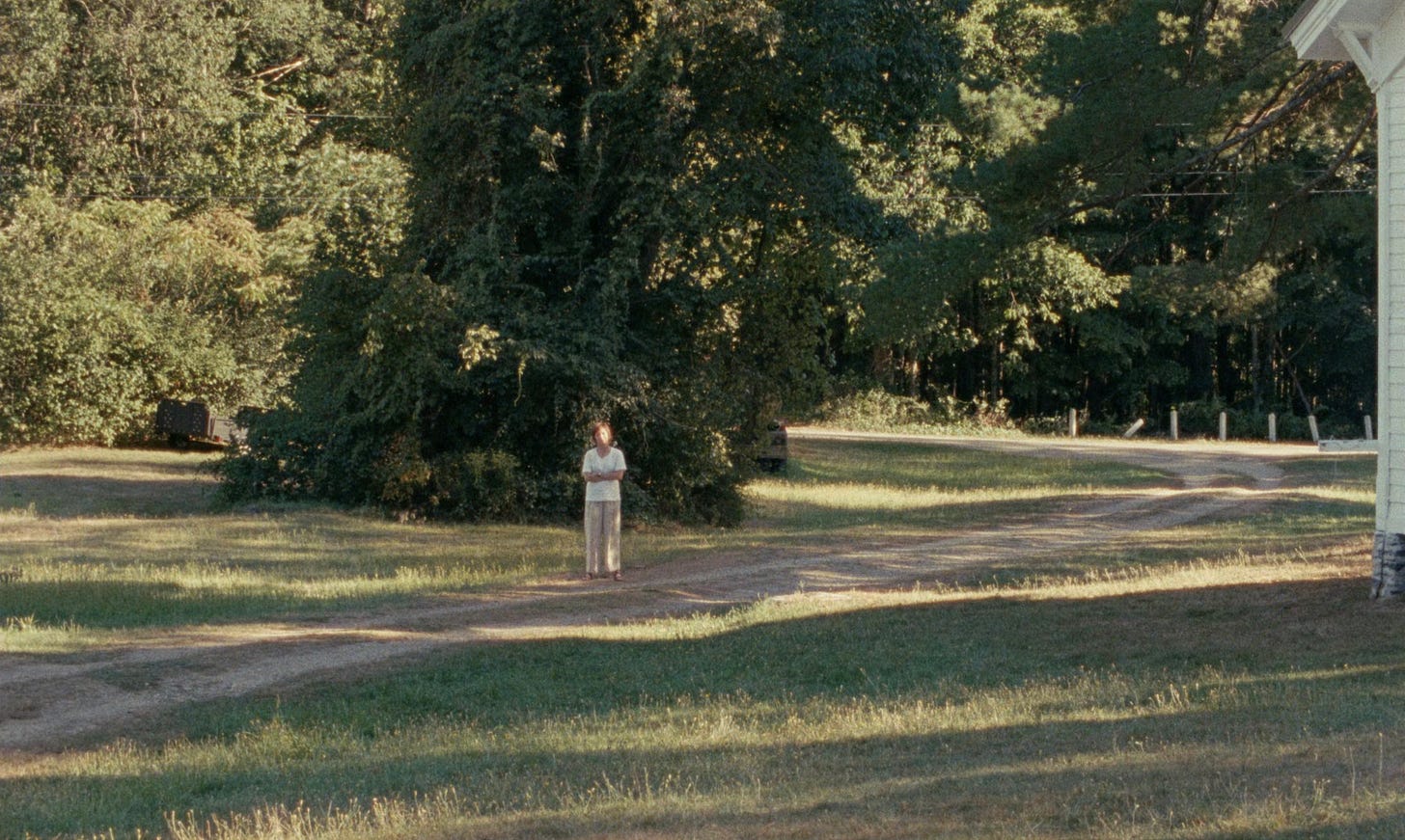In the Frame
A few words about Janet Planet
Just before the pandemic, in the early months of 2020, I attended every screening in TIFF Cinematheque’s Angela Schanelec retrospective. It hadn’t been my intention. I had only vaguely heard of the German filmmaker, but from the very first screening, of her very early short work, I was hooked. More than that, Schanelec’s films were about as life-changing a body of work as I’ve ever experienced. They opened my eyes to a kind of cinema that works outside typical narrative strictures by using perspective crafted through careful framing and editing to imply story and even a world outside the frame. Exposition is practically non-existent in Schanelec’s films, which instead rely on attention to the image and the characters’ interactions within it to illuminate the dynamics one might call a plot. What is foregrounded instead is the complex emotional realities of people, shaped by context, with the audience forced awake to the context found in all that minutiae more often discarded in narrative art. It's a cinema that demands trust in the artist, but grants trust in the viewer as well, and it is no exaggeration to say Schanelec’s work changed the way I understand film, and art, and even the world around me.
Janet Planet, the debut feature from playwright Annie Baker is very different in style, and its experiments are less bold than Schanelec’s, but it is similarly trusting and that trust is rewarded handsomely. Ostensibly a meandering a story of mother and daughter told over the course of a summer, the film anchors itself first in the perspective of the camera, which moves gracefully back and forth between subjective and omniscient, revealing complexities its surfaces would not immediately indicate. Exposition, to the extent it exists in the film, is never dumped. Like in a Schancelec film, Janet Planet asks for the audience’s attention, focusing in on the details—bits of dialogue, moments of performance, features of environment, shapes in architecture—all of which create a universe around its characters, illuminating the dynamics that shape their lives. Watching the film is an enveloping experience (which, I’m sad I was not able to have theatrically, because inexplicable it was denied a run here in Canada), never confusing you about the fact of its artifice, of being the product of craftspeople with real intent, but allowing the space to sink in and find understanding at your own pace.
The film opens in the dark.
A girl, who we’ll later figure is about 11-years-old and is named Lacy, sits awake in bed, the sounds of crickets and other nighttime creatures chirping and buzzing outside.
In a series of barely visible shots, really testing the limits of the 16mm film stock, the girl walks out of a cabin and then runs down a hill toward another building. All of this takes about a minute.
Once inside, Lacy goes to a payphone, the fact of whose existence is the first indication of the 1991 in which the film is set. She’s put no coins in, and after dialling waits a a few moments before having to programmatically state her name, “Lacy.” A collect call, it seems. A few moments longer, and the person on the other end picks up. We don’t see them, or hear them. It’s all Lacy. “Hi,” she says, and without missing a beat adds, “I’m gonna kill myself.” Another moment, Lacy seeming exasperated, her shoulder-length red hair getting tossed a bit as she listens to what must be a bewildered response. “I said I’m gonna kill myself if you don’t come get me.” She hangs up. The title appears.
For essentially all of that opening, time moves with the character. The shots at reasonable distance, barely lit, setting Lacy within an unsettled space. We quickly gather after the title card that she’s at a sleepaway camp for the summer, complete with guitar-playing instructor leading a circle in song.
In fixed shots almost resembling Wes Anderson tableaux, Lacy intrudes on the frame and breaks it; comedic, but also pointed as character portrait. She lies to her cabin mates that she is leaving because her mom’s boyfriend has been injured in a motorcycle accident. The girls are exceedingly kind to her, helping bring out her suitcase, one of them giving her a Troll doll.
“That’s so nice,” Lacy says, lying again, “I don’t wanna go.”
“Is that your mom?” one of the girls asks, and in one of the film’s many hilarious edits, Lacy looks over and the scene cuts to a shot of her mother, Janet, just standing there some distance away.
“Can we meet her?” “I don’t think that’s a good idea.”
The oddness of the moment lingers as Lacy and her mom walk over to each other and embrace in the most loving hug, the two contained within a world all their own.
It all leads to the introduction of a man, Janet’s current boyfriend, not injured, whose face we will never see straight on, and whose affect is both plainly weird, but also clearly annoyed at having to share space in Janet’s life with Lacy.
“Why is Wayne here?”
That question pervades the rest of the film, even as chapter markers of a sort indicate the entrance and exit of characters in Janet’s life over the course of those summer weeks. Each of those characters forms their own relationship with the camera, with the film’s style, as much as with Janet and Lacy. Wayne is defined by distance and obfuscation. Even close-up shots cut off his face, or render it barely in profile from behind. The best look we get at him comes in his most violent moment. Not violent, violent, but sudden and shocking to the otherwise staid tone of the film. It’s a contrast to Wayne’s own young daughter, Sequoia, whose straightforwardly childish energy is what finally breaks the camera out of its slow, static precision in a great rush of excitement. The excitement is only temporary, though, and Lacy’s attraction to it is overwhelmed by her far-too-strong bong with her mother, who remains her be-all and end-all. She has no friends, but evidently not because she’s actually incapable of attracting them.
Later, a friend of Janet’s comes to stay at their ‘70s-era, oddly angular home. Regina is a more free-spirited type, and her warmth is equalled only by her lack of self-confidence in the act of living the day-to-day. It’s why, perhaps, she’s needing a haven from her boyfriend, Avi, the leader of a western Massachusetts hippie theatre collective and minor sex cult. It’s also why the camera, in her presence allows itself a more traditionally framed intimacy, the camera often following her flowing movement in a way not granted other characters. When Regina departs and Avi enters Janet’s life, something more spiritual takes hold in the filmmaking. The camera becomes static again, warily enraptured by him in his soft-spoken, magnetism. Shots from a picnic Janet goes on with him late in the film feel more “artful,” which is to say, more manicured, than anything previous. When comes time for his departure, the film explicitly breaks form. Cut out of the frame and then cut out of the picture.
Throughout the film, characters are often cut off by the frame, or cut out entirely. Sometimes it’s because we are given a view through Lacy’s limited childhood perspective. Other times it’s a more outside, objective view. The lines between those perspectives regularly blur, and rather than dilute their respective power, the depth of the film grows from the dissonance and inability to ever parse completely. These are lives we’re watching. Characters, sure, in a little play not unlike the figurines Lacy arranges into scenes behind a curtain on a shelf in her bedroom, but characters born from the intangibles of reality.
Annie Baker was recently on Sam Fragoso’s great Talk Easy podcast (which I’m proud to have helped produce at launch in 2016, back when we originally tried in vain to have Baker appear), and he proposed Janet Planet is no ordinary mother-daughter story. Those are usually typified by misunderstanding that breeds a kind of understanding and newfound bond as the child grows more mature. Baker’s film, he suggests, is a story about a daughter falling out of love with her mother. That may be a tad too neat (the filmmaker herself bristles a bit at the simplification), but it’s nonetheless perceptive. A single mother—watching her daughter grow into her tweens, still too dependent for her age, too averse to forming friendships with other kids—goes through the motions of dating and forging a life as a middle-aged woman. A daughter—watching her mother live a life of contradictions and mistakes, unable to allow herself real stability—begins to see the distance forming between them as teenage years loom.
In her filmmaking, Baker allows the frame (and sound) to dictate perspective, but always expanding the scope of what it can see, even as it responds by limiting the literal view. As the film progresses we come to understand Lacy’s unusual intelligence, and her mother’s admiration and encouragement of it. This is a girl who can tell her mom—who she still insists on sleeping with each night, by the way—“Every day of my life is hell,” and rather than admonishment or grave concern for the mental state of an 11-year-old child, gets back a very adult confession of depressive struggle. What we see is a relationship whose love and mutual respect is beautiful, genuinely, but also too needy to be healthy and too permissive to be sustainable. Critic and friend Mark Asch has written, “This film for me is about what it’s like when your parent thinks you’re smarter than them, the bullshit they don’t call you on and the scared little choices of yours that they don’t veto, because you seem so self-sufficient; Lacy will be fine, but when the movie leaves her she’s so lonely and flailing.” In its final series of shots, Janet Planet locks in its perspective, and for the first time the editing elides moments in quick succession. The swiftness is startling and gripping, the antithesis of the film’s slow crawl of an opening. In those last moments, as Lacy’s world literally spins before her eyes, Baker weaves together the film's many disparate strands, culminating in a sensation of true, devastating realization. The screen goes black and we are left with all that is the future.















